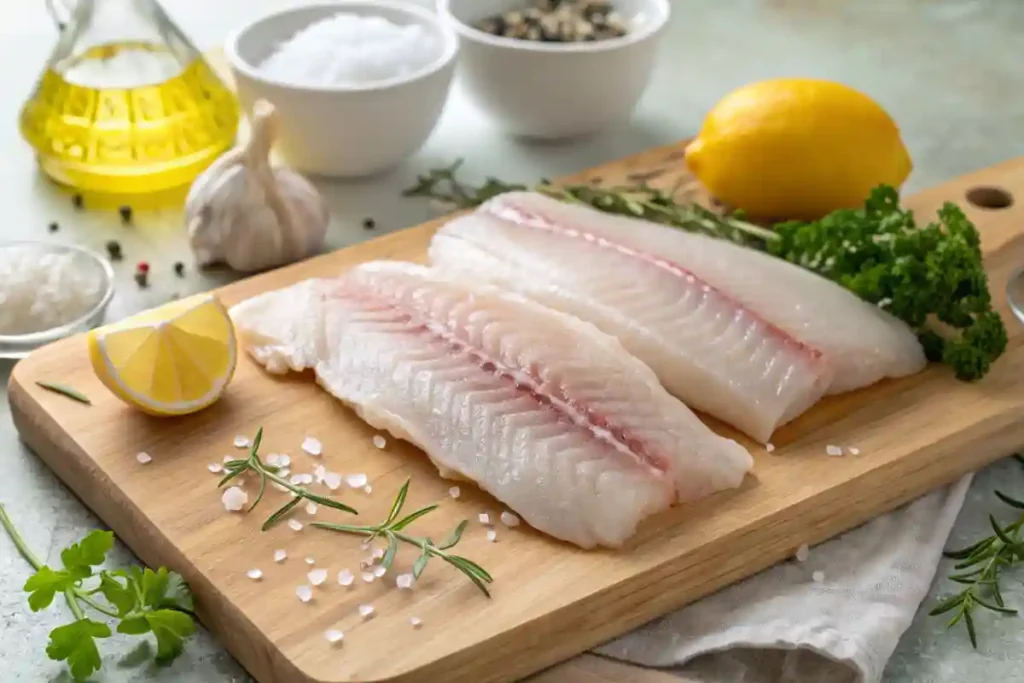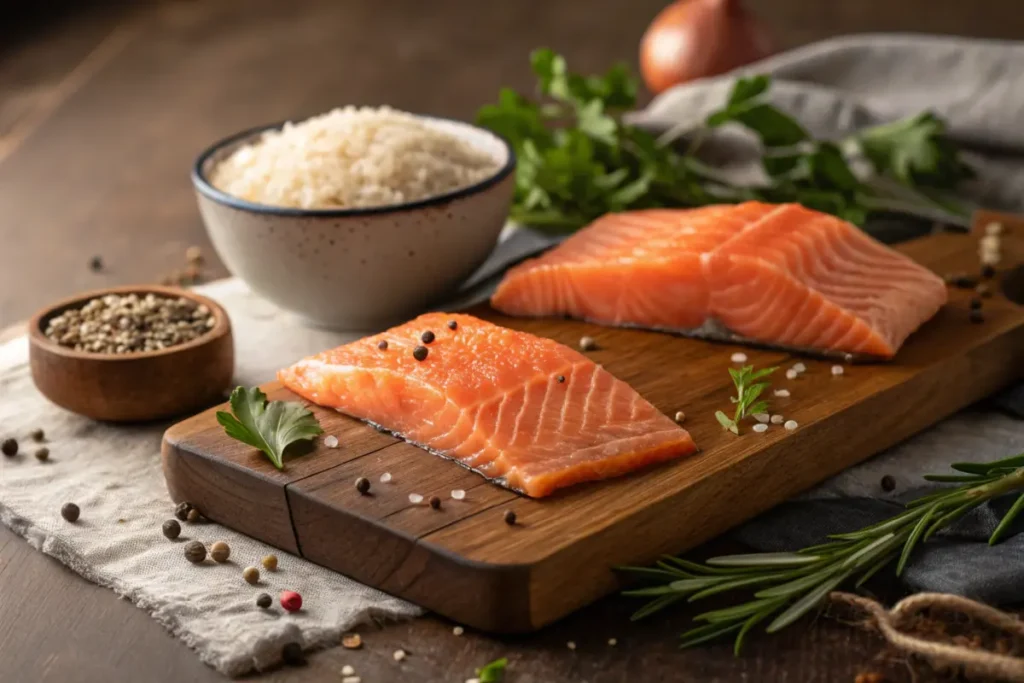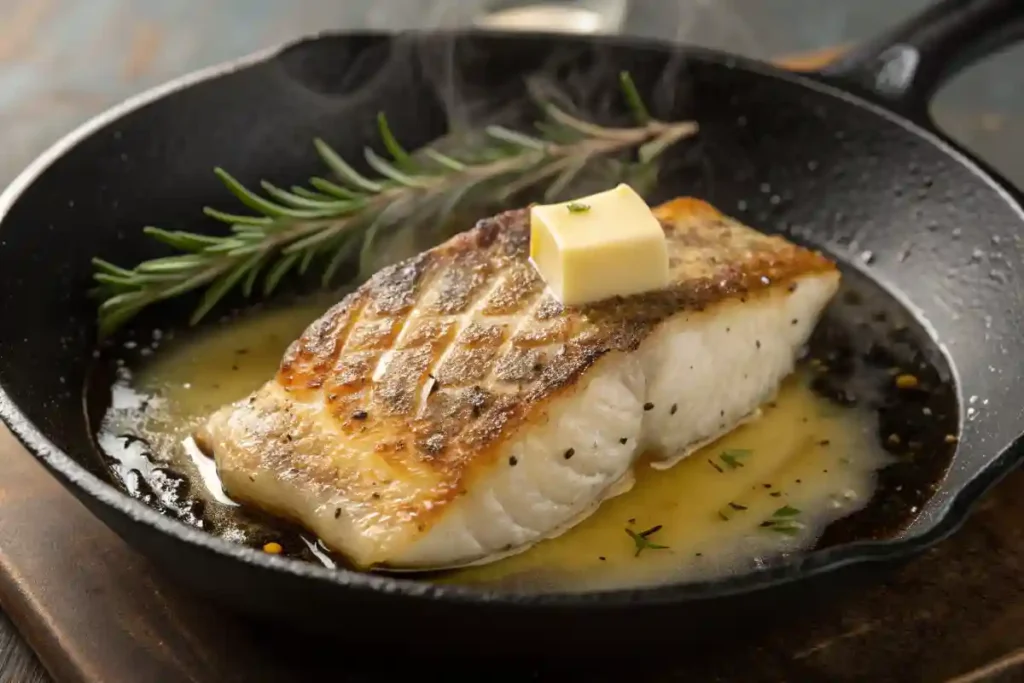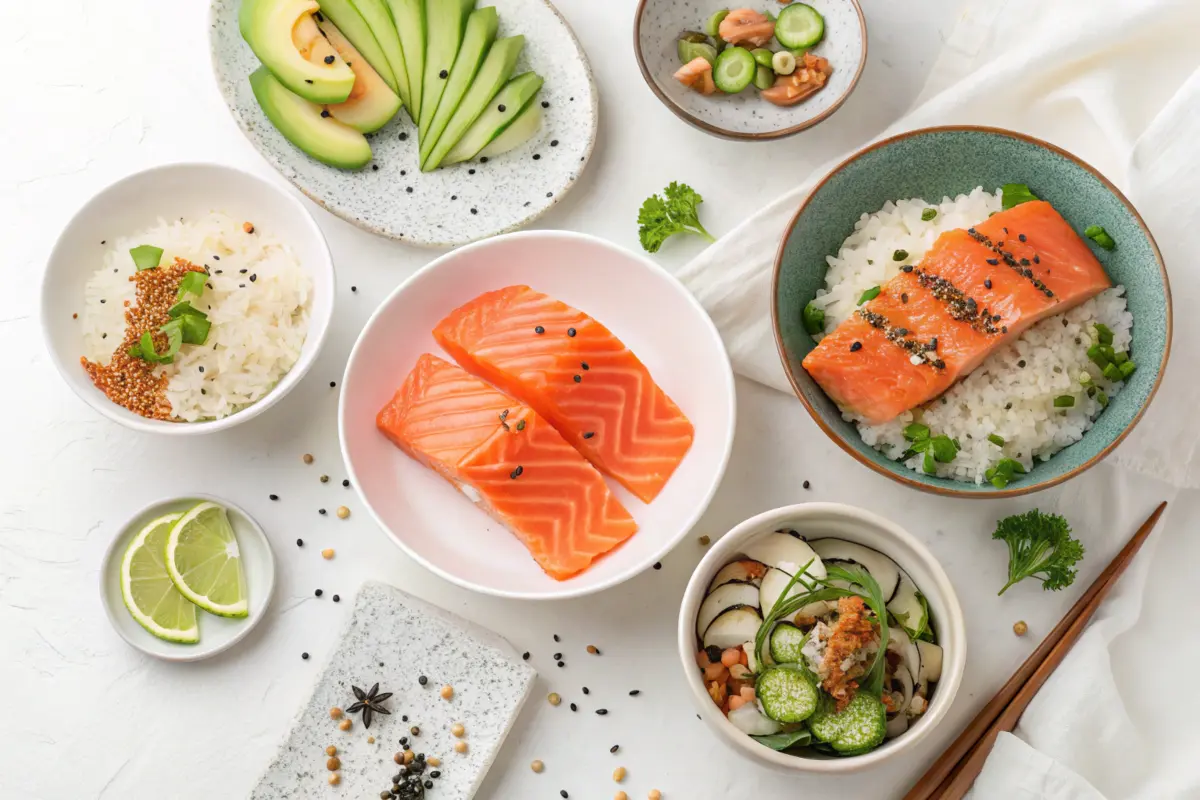When it comes to satisfying, nutritious meals, salmon and rice recipes really take the cake—or, rather, the bowl. This combo blends rich, melt-in-your-mouth fish with grains that carry flavors like a gentle canvas. In fact, salmon’s natural oils and flaky texture pair beautifully with rice’s comforting fluffiness, helping transform a simple dinner into something delightfully complex. Along the way, you’ll discover countless variations: grill the salmon until it boasts a crispy crust, steam or bake it gently for tenderness, or glaze it with sweet or tangy sauces. Get ready to learn essential cooking techniques, explore diverse flavor profiles, and master the art of building an unforgettable salmon and rice dish.

Why Choose Salmon and Rice?
The Appeal of Salmon and Rice
It’s no wonder salmon and rice often share the spotlight. They’re a culinary power couple—salmon’s creamy, delicate flavor harmonizes perfectly with rice’s mild, starchy goodness. Together, they create a canvas for infinite creativity, allowing you to layer herbs, spices, or vegetables to find that sweet spot between comfort and excitement. Beyond their deliciousness, these ingredients support a balanced meal packed with essential nutrients. When you’re juggling a busy schedule, the simplicity of tossing salmon and rice together is a lifesaver, quickly evolving into a dish that both satisfies hunger and pleases your palate in equal measure.
Nutritional Benefits and Balanced Meals
In terms of nutrition, salmon and rice strike gold. Salmon contributes lean protein and heart-friendly omega-3 fatty acids, known to support brain, heart, and overall well-being. Meanwhile, rice—particularly whole-grain varieties like brown rice—offers complex carbs that release energy steadily, keeping you feeling satisfied and energized. Together, these elements ensure a balanced plate that doesn’t skimp on flavor. Try pairing these essentials with nutrient-dense produce, tossing in crunchy veggies, or sprinkling fresh herbs for a one-bowl wonder that nurtures both body and soul. With salmon and rice, you’re not just enjoying a meal; you’re also investing in your health.
Cultural and Culinary Roots
From the shores of Japan to the bustling kitchens of Scandinavia, salmon and rice hold prominent places in global cuisine. Think buttery salmon sashimi alongside vinegared sushi rice or a Scandinavian-inspired roast served over fragrant basmati. This pairing transcends cultural boundaries, offering countless fusion options. Let creativity guide you as you borrow flavor palettes from diverse traditions. Exploring different influences ensures your salmon and rice recipes never become dull—each attempt can reveal a fresh facet of this timeless duo’s charm.
Selecting the Best Salmon and Rice

Choosing Quality Salmon
Selecting high-quality salmon is the cornerstone of any outstanding salmon and rice recipes. Opt for fresh, wild-caught salmon when possible, as it tends to have a richer flavor and firmer texture compared to farmed varieties. Fresh salmon should have vibrant, shiny flesh and a mild, ocean-like scent—any strong or fishy odors might indicate it’s past its prime. If fresh isn’t available, frozen salmon is a reliable alternative; just ensure it’s been properly stored and thawed in the refrigerator to maintain its integrity. Additionally, look for sustainably sourced options by consulting resources like the sustainable seafood source, which provides guidelines on choosing environmentally responsible seafood. Investing in quality salmon not only enhances the taste of your dishes but also ensures you’re supporting sustainable practices, making your meals both delicious and conscientious.
Salmon Cuts and Varieties
Understanding different salmon cuts and varieties can elevate your salmon and rice recipes. Fillets are versatile and easy to cook, ideal for grilling, baking, or pan-searing, while steaks offer a hearty texture that withstands robust seasonings and sauces. Skin-on salmon adds extra flavor and helps keep the fish moist during cooking, perfect for grilling or roasting where the skin can crisp beautifully. Conversely, skinless cuts are convenient for quick stir-fries or delicate dishes where crispy skin isn’t desired. Varieties like King (Chinook), Sockeye, and Coho each have unique flavor profiles and fat contents—King salmon is the fattiest and richest, Sockeye has a deep, robust taste, and Coho balances the two. Choosing the right cut and variety based on your recipe ensures a perfectly textured and flavorful outcome every time.
Rice Types and Their Characteristics
The type of rice you choose can significantly influence the texture and overall success of your salmon and rice recipes. White rice is versatile and cooks quickly, providing a light, fluffy base that complements the rich flavor of salmon. Brown rice, with its nutty taste and chewy texture, adds a hearty element and increased nutritional value thanks to its higher fiber content. Jasmine rice offers a fragrant aroma and slightly sticky texture, making it ideal for Asian-inspired dishes like teriyaki or miso-glazed salmon bowls. Basmati rice is long-grained and aromatic, perfect for pairing with Mediterranean or Middle Eastern seasonings. Each rice variety brings its own unique characteristics, allowing you to tailor your dish to specific flavor profiles and textures. For detailed cooking methods and achieving perfectly cooked rice, refer to the perfectly cooked rice resource.
Essential Tools and Kitchen Prep
Kitchen Equipment for Salmon and Rice Recipes
Creating standout salmon and rice recipes starts with having the right tools in your kitchen arsenal. A nonstick skillet or cast-iron skillet is indispensable for achieving that perfect sear on your salmon, ensuring a crispy exterior while keeping the flesh tender and juicy. Additionally, a reliable rice cooker can simplify the process of cooking rice to perfection, eliminating the guesswork associated with stovetop methods. If you prefer traditional cooking, a sturdy saucepan with a tight-fitting lid is essential for simmering rice without it drying out. Don’t overlook the importance of sharp knives for filleting salmon cleanly, which not only improves presentation but also ensures even cooking. Investing in these key pieces of equipment sets the foundation for consistently delicious and visually appealing salmon and rice dishes. For more insights on choosing the right tools, explore expert salmon techniques.
Preparing Salmon for Cooking
Proper preparation of salmon is crucial to maximize flavor and texture in your salmon and rice recipes. Start by patting the salmon dry with paper towels; this step is essential for achieving a beautiful, crispy skin when pan-searing or grilling. Removing any pin bones using tweezers ensures a smooth eating experience and prevents any unpleasant surprises. If you’re using frozen salmon, ensure it is thawed properly by placing it in the refrigerator overnight or using the cold-water method for a quicker thaw. Avoid using a microwave to thaw salmon, as it can begin to cook the fish unevenly, leading to an inconsistent texture. Additionally, consider marinating your salmon ahead of time to infuse it with extra flavor—simple marinades with citrus, herbs, and a touch of soy sauce can elevate the dish significantly. These preparation steps help ensure that your salmon is flavorful, tender, and perfectly cooked every time.
Prepping Rice for Perfect Texture
Achieving the ideal rice texture is crucial for your salmon and rice dishes. Begin by rinsing the rice under cold water until it runs clear to remove excess starch and prevent gumminess. Use a water-to-rice ratio of 2:1 for most long-grain varieties like jasmine or basmati, but always check the package instructions for best results. After cooking, let the rice rest covered for about 10 minutes off the heat. This allows the grains to firm up and moisture to distribute evenly, resulting in fluffy, separate grains instead of a sticky mass. For an extra touch, fluff the rice with a fork before serving to enhance its lightness. Mastering these rice preparation techniques ensures a perfect foundation for your salmon dishes, allowing the rice to absorb and complement the rich flavors of the salmon and seasonings. For more detailed cooking methods, refer to the perfectly cooked rice guide.
Cooking Methods and Techniques
Pan-Searing and Grilling Salmon
Pan-searing and grilling are excellent methods for salmon and rice recipes, enhancing both flavor and texture. To pan-sear, heat a nonstick or cast-iron skillet over medium-high heat and add a splash of oil. Once shimmering, place the salmon skin-side down, pressing gently for even contact. Cook undisturbed for 4-5 minutes until the skin is golden and crisp, then flip to finish to your desired doneness. Grilling adds a smoky, charred flavor ideal for outdoor meals. Preheat the grill to medium-high, oil the grates to prevent sticking, and place the salmon fillets skin-side down. Grill for 6-8 minutes per side, depending on thickness, until the salmon flakes easily with a fork. Both techniques lock in moisture and highlight the salmon’s natural flavors, making them essential for salmon and rice dishes. For more detailed methods, consult expert salmon guides.
Roasting and SalmonBaking
Baking and roasting are gentle cooking methods that preserve salmon’s delicate texture and rich flavors, making them excellent for salmon and rice recipes. To bake, preheat the oven to 400°F (200°C) and place salmon fillets on a parchment-lined baking sheet. Season with herbs, lemon slices, and a drizzle of olive oil, then bake for 12-15 minutes until opaque and flaky. Roasting uses higher heat for a shorter time to achieve a caramelized exterior. Preheat to 425°F (220°C), place salmon on a rack in a roasting pan to ensure even heat circulation, and roast for 10-12 minutes until succulent with a hint of crispiness. Both methods allow for creative seasoning, keeping your salmon and rice dishes exciting and delicious.
Poaching and Steaming Salmon
Poaching and steaming are ideal for those who prefer a delicate touch, highlighting salmon’s natural flavors without added fat. To poach, gently simmer salmon in a flavorful liquid like broth, white wine, or a herb-infused mixture in a large skillet. Cover and cook for 10-12 minutes until just done, keeping the fish moist and tender—perfect for lighter salmon and rice recipes. Steaming preserves the salmon’s integrity while imparting subtle flavors. Place fillets in a steamer basket over boiling water without submerging and steam for 8-10 minutes, depending on thickness. Both methods allow gentle flavor infusion, making them excellent choices for dishes that prioritize the salmon’s natural taste. These techniques are especially suitable for healthy, low-fat meals focused on clean, pure flavors.
Flavor Profiles and Seasonings
Marinades, Rubs, and Glazes
Elevating your salmon and rice recipes involves mastering marinades, rubs, and glazes. These add depth and complexity, transforming a simple fillet into a gourmet dish. Citrus-soy marinades offer a tangy, umami-rich profile ideal for quick weeknight meals. Combine soy sauce, lemon juice, garlic, and honey for a balanced glaze that caramelizes when grilled or baked. Honey-ginger glazes provide a sweet and spicy kick, complementing salmon’s richness. Mix honey, grated ginger, and rice vinegar, then brush onto fillets in the last minutes of cooking for a sticky finish. For bold flavors, miso or teriyaki infusions offer a savory, slightly sweet taste that pairs well with brown or jasmine rice. Experimenting with these marinades and glazes enhances flavor and adds a professional touch to your dishes. For more techniques, explore expert salmon guides.
Herbs, Spices, and Aromat
Incorporating Vegetables and Sauces
Adding vegetables and sauces to your salmon and rice recipes brings both nutrition and vibrant flavors. Roasted broccoli, stir-fried bok choy, and grilled asparagus add texture and color. These additions make the dish more visually appealing and nutritionally balanced. Creamy avocado sauce or a tangy citrus vinaigrette can enhance the salmon’s richness. They provide a luscious complement to the fluffy rice. Crunchy radish slices or pickled vegetables introduce a refreshing contrast. They cut through the salmon’s richness and add layers of flavor. These additions not only elevate the taste but also ensure a well-rounded, satisfying meal. They please both the eyes and the palate.
Building a Salmon Rice Bowl
Creating a salmon rice bowl involves layering flavors and textures. This creates a harmonious and satisfying meal. Start with your chosen rice—brown, jasmine, or basmati. This provides a hearty foundation. Add your cooked salmon, whether it’s pan-seared, grilled, or baked. Ensure the salmon is tender and flavorful. Layer in pickled veggies, such as carrots or cucumbers, for a tangy bite. Sprinkle sesame seeds to add a nutty crunch. Fresh citrus squeezes like lemon or lime can brighten the dish. Herb garnishes like cilantro or parsley add color and freshness. By thoughtfully combining these elements, your salmon rice bowl becomes balanced, nutritious, and delicious. It’s easy to prepare and delightful to eat.
Recipe Ideas and Inspirations
Classic Grilled Salmon with Lemon Rice
For a timeless favorite, try the Classic Grilled Salmon with Lemon Rice. Marinate your salmon fillets in olive oil, lemon juice, garlic, and fresh herbs like dill or parsley. Preheat your grill to medium-high heat. Cook the salmon for about 4-5 minutes per side. This achieves a perfect char while keeping the interior moist and flaky. Serve alongside fluffy lemon-infused rice. Prepare the rice by adding lemon zest and a splash of lemon juice to cooked jasmine or basmati rice. This combination offers a bright, zesty flavor that enhances the rich taste of the salmon. It creates a balanced and satisfying meal that is both elegant and easy to prepare.

Teriyaki Salmon Bowl with Brown Rice
Elevate your meal with a Teriyaki Salmon Bowl and brown rice. Glaze your salmon with teriyaki sauce. Use homemade or store-bought sauce. Let the salmon soak for at least 30 minutes. Cook nutty brown rice as the base. This provides a hearty, fiber-rich foundation. Pan-sear or bake the teriyaki-glazed salmon. Cook until tender and caramelized. Assemble your bowl by layering the brown rice. Add the succulent salmon on top. Garnish with steamed vegetables like broccoli and snap peas. Sprinkle sesame seeds and sliced green onions for extra flavor and crunch. This dish tastes amazing and packs a nutritional punch. It is perfect for a wholesome lunch or dinner.
Miso-Glazed Salmon with Basmati Rice
Discover the umami-rich delight of Miso-Glazed Salmon with Basmati Rice. Create a miso glaze by combining white miso paste, mirin, soy sauce, and honey or maple syrup. Brush this mixture generously over your salmon fillets. Let them marinate for at least an hour to absorb the flavors. Bake the salmon in a preheated oven at 400°F (200°C) for 12-15 minutes. Cook until the salmon is beautifully glazed and flaky. Pair it with fragrant basmati rice, cooked to perfection. The rice complements the savory miso glaze. Add a side of sautéed bok choy or steamed green beans to round out the meal. This recipe offers a sophisticated twist on traditional salmon dishes. It is perfect for impressing guests or enjoying a gourmet meal at home.
Sushi-Inspired Salmon and Rice Rolls
Bring the art of sushi into your kitchen with Sushi-Inspired Salmon and Rice Rolls. Use nori sheets to wrap seasoned sushi rice and fresh salmon slices. Add avocado and cucumber for extra crunch. Slice the rolls into bite-sized pieces. Serve with soy sauce, pickled ginger, and wasabi. This makes an authentic and delightful appetizer or light meal.
Nutrition, Sustainability, and Tips
Health Benefits of Salmon and Rice Meals
Combining salmon and rice recipes isn’t just delicious—it’s a nutritional powerhouse. Salmon is renowned for its high-quality protein and abundant omega-3 fatty acids. These fats are essential for heart health, brain function, and reducing inflammation. They also contribute to glowing skin and a strong immune system. Rice, especially whole-grain varieties like brown or basmati, provides complex carbohydrates. These carbohydrates deliver sustained energy and keep you feeling full longer. Additionally, rice is a great source of fiber, vitamins, and minerals. It supports digestive health and overall well-being. Together, these ingredients create a balanced meal that nourishes both body and mind. Your salmon and rice dishes are as beneficial as they are tasty.
Sustainable Seafood Choices
In today’s eco-conscious world, making sustainable seafood choices is more important than ever. Opt for wild-caught salmon or those certified by organizations like Seafood Watch by Monterey Bay Aquarium. This ensures your salmon and rice recipes support responsible fishing practices and environmental stewardship. Sustainable salmon farming reduces the impact on wild populations. It also minimizes habitat disruption. Look for labels such as MSC-certified (Marine Stewardship Council) or ASC-certified (Aquaculture Stewardship Council). These labels guarantee that your seafood is sourced ethically. By choosing sustainable options, you enjoy delicious meals. You also contribute to the preservation of marine ecosystems for future generations.
Meal Prep and Leftover Suggestions
Maximize the versatility of your salmon and rice recipes by incorporating meal prep strategies and making the most of leftovers. Bulk cooking salmon fillets and rice at the beginning of the week can save time and streamline your dinner routine. Store cooked salmon and rice separately in airtight containers in the refrigerator for up to three days. Use leftovers in stir-fries, salads, or wraps to create new and exciting meals without additional cooking. For those who love variety, try transforming leftover salmon into a salmon salad with fresh greens and a tangy vinaigrette, or mix rice with vegetables and a splash of soy sauce for a quick fried rice dish. These tips not only reduce food waste but also ensure you always have a nutritious and tasty meal ready to go.
FAQs (People Also Ask)
Can I use any type of salmon for these recipes?
Absolutely! You can use various types of salmon such as King (Chinook), Sockeye, or Coho based on your flavor preference and budget. Each type offers a unique taste and texture, allowing you to customize your dish. Wild-caught varieties tend to have a richer flavor compared to farmed ones.
Is brown rice healthier than white rice for salmon dishes?
Yes, brown rice retains more nutrients and fiber compared to white rice, making it a healthier option. It provides sustained energy and complements the rich flavor of salmon well. However, white rice cooks faster and has a softer texture, which some may prefer depending on the recipe.
How do I ensure my salmon is fully cooked?
Use a meat thermometer to check that the internal temperature reaches 145°F (63°C). The flesh should be opaque and easily flake with a fork. Alternatively, visually inspect for doneness by ensuring the center is no longer translucent. Properly cooked salmon is both safe and delicious.
Can I make salmon and rice recipes ahead of time?
Yes, many salmon and rice recipes can be prepared in advance. Store cooked salmon and rice separately in airtight containers in the refrigerator for up to 3 days. Reheat gently on the stovetop or in the microwave, adding fresh herbs or sauces as needed to maintain flavor and texture.
What sauces work best with salmon and rice dishes?
Sauces like teriyaki, lemon butter, creamy dill, and miso glaze pair excellently with salmon and rice. These sauces enhance the flavors without overpowering the delicate taste of salmon, providing a balanced and flavorful meal. Experiment with different sauces to find your favorite combination.
Conclusion
Recapping the versatility and nutritional powerhouse that salmon and rice recipes offer, it’s clear why this combination remains a staple in kitchens worldwide. From selecting the freshest salmon and the perfect rice type to mastering various cooking techniques and exploring diverse flavor profiles, there’s something for every palate. Embrace the sustainability of choosing responsibly sourced seafood and enjoy the myriad health benefits these meals provide. Whether you’re prepping ahead for busy weeks or crafting a gourmet dinner, these recipes are designed to delight and nourish. So, dive into the world of salmon and rice, experiment with new flavors, and savor the delicious, balanced meals you create.

